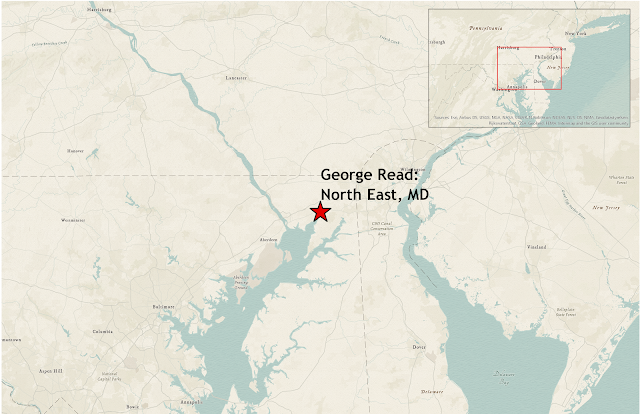Founding Fathers - George Read
George Read
Born: September 18, 1733 (Cecil County, Maryland)
Died: September 21, 1798 (New Castle, Delaware)
Last week we looked at George Ross, who was perhaps better known for one of his relatives than for his own actions. This week we'll get to know another George who also ended up being related to Ross, and perhaps it isn't surprising that they came from the same area, although they represented different states. George Read was the oldest son born at home on his family's land in Cecil County, Maryland, near the town of North East. His parents were named John and Mary - John was a colonel and wealthy landowner originally from Dublin, and Mary was the daughter of a Welsh planter. Born near the intersection of three modern states (although Delaware was then part of Pennsylvania, although it had its own assembly), he spent portions of his childhood in all three. Shortly after his birth, the family relocated to New Castle, Delaware, and young George attended schools in both Chester and New London, Pennsylvania. After receiving a strong classical education, George began studying law in Philadelphia under the leader of Pennsylvania's bar, John Moland. By the age of 19 he had been admitted to the bar himself, and returned to New Castle the following year to began his legal practice. In 1763 he married the widowed sister of George Ross, and the couple had four sons and a daughter together.
The year of George Read's wedding also witnessed his entry into public service, as Pennsylvania's royal governor John Penn appointed him as attorney general of the three Delaware counties. When the Stamp Act was passed in 1765, Read quickly opposed it and took it as his duty as a royal official to inform the British government that such taxation without a representative in Parliament was likely to incite rebellion. He was elected to the colonial legislature the same year, and held both of his positions concurrently until 1774. While becoming increasingly sympathetic to the resistance against British meddling in colonial affairs, Read remained in favor of non-violent protest, including boycotts and written objections. Like the majority in Delaware, he believed calls for independence were premature and continued to work towards reconciliation with the Crown. And yet he was active in the patriotic movement, serving for several years on the Committee of Correspondence before being chosen as a delegate to the Continental Congress in 1774, although his attendance was inconsistent. He signed the Olive Branch Petition in 1775, and surprised many by siding against the motion to declare independence on July 2, 1776, necessitating the late-night ride of Caesar Rodney to break the Delaware delegation's stalemate in favor of passage. Read became the only man to vote against the Declaration of Independence but still sign the document once it had been agreed upon. If there were any doubts about his commitment to freedom, however, they were cast aside when he proposed a motion to brand anyone who would break the agreement set forth in the Declaration as a traitor.
George Read's career had been marked by maintaining diplomatic neutrality between extreme factions, and this made him an acceptable choice to lead Delaware, which was by that time finally separate from Pennsylvania. He presided over the state's constitutional convention, and became the state's second president (now governor) after his predecessor was captured by the British in 1777. Read himself paid a heavy price for his support of independence, as his home was taken by the enemy and his wife was held captive for a period of time. He returned to the state legislature in 1778 and supported the signing of the Articles of Confederation, but resigned the following year due to illness. After regaining his health, Read was appointed as judge for the National Court of Appeals in Admiralty in 1782. Delaware chose him as a representative to the convention that ultimately drafted the new US Constitution, and he was a leading proponent of protecting the rights of smaller states against their more populous neighbors. When the Constitution was approved, with his state being the very first to ratify, Read became one of the first US Senators and served for four years before resigning to assume his role as Chief Justice of Delaware in 1793. Five years later, and just three days after reaching his 65th birthday, George Read died of heart problems and was buried at the cemetery beside Immanuel Church, where his father-in-law had served as rector.
The signature of George Read can be found as the eleventh signature in the fourth column beneath the Declaration of Independence.




Comments
Post a Comment